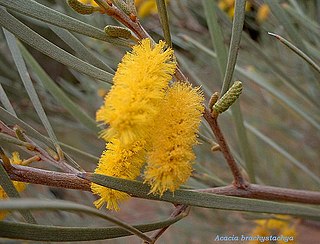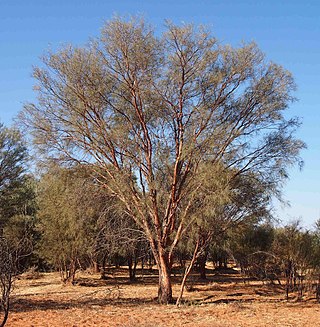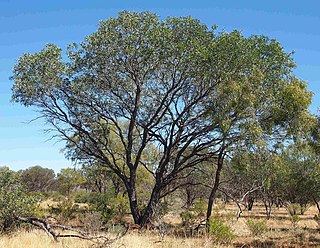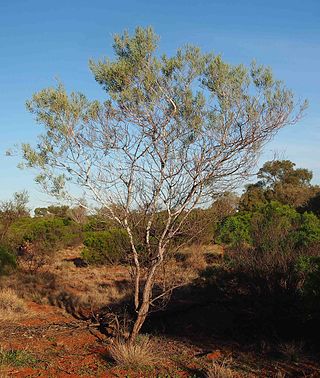
Acacia brachystachya, commonly known as umbrella mulga, turpentine mulga or false bowgada, is a shrub in the family Fabaceae. The species occurs in mulga and heath communities on sandhills and rocky ridges in all mainland states of Australia, except Victoria.

Acacia coolgardiensis, commonly known as sugar brother or spinifex wattle, is a shrub in the family Fabaceae. Endemic to Western Australia, it is widely distributed in the semi-arid spinifex country from Carnarvon to Kalgoorlie.

Acacia craspedocarpa, commonly known as hop mulga or the broad-leaved mulga, is a shrub or tree in the family Fabaceae native to central parts of western Australia.

Acacia cuspidifolia, commonly known as wait-a-while or bohemia, is a tree in the family Fabaceae. Endemic to Western Australia, it occurs on the floodplains east of Carnarvon.

Acacia cyperophylla, commonly known as creekline miniritchie or red mulga, is a tree in the family Fabaceae. The species' range extends across arid and semi-arid regions of Central Australia, from Carnarvon in Western Australia through the Northern Territory and northern South Australia to western Queensland. It is commonly found growing in areas of slightly higher soil moisture such as in drainage lines and on the banks of rivers and creeks.

Acacia grasbyi, commonly known as miniritchie, is a shrub or tree in the family Fabaceae that is endemic to parts of arid western and central Australia.

Acacia kempeana, commonly known as wanderrie wattle, witchetty bush or granite wattle, is a shrub in subfamily Mimosoideae of family Fabaceae that is endemic to arid parts of central and western Australia.

Acacia inaequilatera, commonly known as kanji bush, baderi, camel bush, fire wattle, kanyji bush or ranji bush is a tree in the family Mimosaceae. Endemic to Australia, it is widely distributed in the semi-arid Triodia country eastwards from Karratha, Western Australia into the Northern Territory.

Acacia hemiteles, commonly known as tan wattle, is a shrub in the family Fabaceae. It is widely distributed throughout south central Western Australia. It was formerly thought to be endemic to Western Australia, but has recently been collected near Maralinga in South Australia. Tan wattle is a good coloniser of disturbed or burnt ground, and is therefore often seen in mining areas.

Acacia tetragonophylla, commonly known as curara, kurara or dead finish, is a tree in the family Fabaceae that is endemic to arid and semi-arid parts of central and western Australia.

Acacia subtessarogona, commonly known as spreading gidgee, is a tree in the family Fabaceae and the subgenus Juliflorae that is native to a small area in western Australia.

Acacia sclerosperma, commonly known as limestone wattle or silver bark wattle, is a tree in the family Fabaceae. Endemic to Western Australia, it occurs on floodplains and along water-courses throughout the arid north-west corner of the State.

Acacia quadrimarginea, commonly known as granite wattle or spreading wattle, is a tree in the family Mimosaceae. Endemic to Western Australia, it occurs through arid south-central Western Australia. It is common on granite, but also occurs on sand and clay, and is often seen along creeklines in rocky hills.

Acacia pruinocarpa, commonly known as black gidgee, gidgee or tawu, is a tree in the family Fabaceae that is endemic to arid parts of Australia.

Acacia papyrocarpa, commonly known as western myall, is a tree in the family Fabaceae native to arid areas of central and western Australia.

Acacia murrayana is a tree in the family Fabaceae. It has numerous common names, including sandplain wattle, Murray's wattle, fire wattle, colony wattle and powder bark wattle, and is endemic to arid areas in every mainland state except Victoria.
Acacia ramulosa var. linophylla, commonly known as bowgada, wanderry mulga, horse mulga or sometimes wanyu, is a subspecies of the tree species Acacia ramulosa, with which it shares several common names. While the parent species is found throughout arid Australia, this subspecies is much more restricted, being found only on loose red sand in south central Western Australia and sporadically in South Australia. The species was formally named Acacia linophylla until 2001, when it was recognised as a variety of Acacia ramulosa.

Allocasuarina decaisneana, commonly known as desert oak, desert sheoak, or kurkara by the Anangu peoples, is a species of flowering plant in the family Casuarinaceae and is endemic to Central Australia. It is a dioecious tree that typically grows to a height of 10–16 m (33–52 ft) and has long, drooping branchlets, the leaves reduced to scales in whorls of four, the mature fruiting cones 28–95 mm (1.1–3.7 in) long containing winged seeds (samaras) 8.5–17 mm (0.3–0.7 in) long.

Acacia sericophylla is a shrub or tree commonly known as the desert dogwood, desert oak or cork-bark wattle. To the Indigenous Australian people of the Pilbara, the Nyangumarta peoples, it is known as Pirrkala. The species is of the genus Acacia and the subgenus Plurinerves.

Acacia pentadenia, commonly known as karri wattle, is a shrub or tree of the genus Acacia and the subgenus Pulchellae.




















